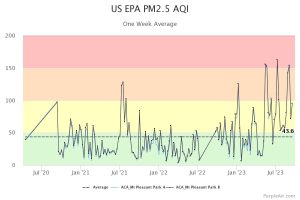October 5, 2023
By Morgan Lievers, BRWA Environmental Program Coordinator
There have been over 1,000 wildfires in our province since March 1st, recorded on the Alberta Wildfire Status Dashboard. After seeing the articles about Edmonton breaking records with more than 250 smoke hours, we were interested in finding data in the Battle River watershed. Our watershed does not have air monitors located in every city, so we are looking at Camrose for our centralized location. Everyone in Canada and surrounding countries are affected by the increasing number of wildfires and smoke. Read on to learn more about the number of smoky days in this region, health effects, what you can do during smoky weather, and some of the common causes of wildfires.
Using the Purple Air monitors from Camrose, a weekly average of air quality between July 2020 and September 2023 is shown in the graph below. Anything over 100 on this index is seen as unhealthy, and people should avoid outside activities. Digging deeper into the data for this year, between April and September 2023 the Camrose area had over 60 days (approximately 1440 hours) in the orange and red zone with poor or unhealthy air quality. A third of the time the average index was over 100 and even over 150.

Using data from the Alberta Wildfire Status Dashboard from the past 5 years, there were fewer fires in 2023 compared to wildfires in 2021, but the damage from the fires was much more extensive this year. Over 2 million hectares were burned this year compared to 100,000 hectares burned in 2022. That is 20 times more area that we have lost to this wildfire season, making a new record. Drought and warming temperatures have been the main factors in providing the perfect conditions for the rapid spread of wildfires. As climate change is expected to increase temperatures and the frequency of severe weather events, longer wildfire seasons are predicted by the UN environment programme. With longer periods of burning at such a large scale, people all over the world will be impacted by the massive amounts of smoke.
The presence of high amounts of smoke particles in the air can have many adverse effects on your health. It is not just the initial smoke people have to worry about. An article from the European Commission featured a study looking at how smoke lingers and reacts with the atmosphere. It was found that over time the smoke becomes more toxic resulting in possible long-term health impacts. Inflammatory illnesses, such as asthma or allergies, can worsen with smoke. Prolonged exposure can cause headaches, cough, sore eyes and throat, and other symptoms.
Environment and Climate Change Canada advises to reduce exposure to smoke as much as possible, and to go inside if you start to experience symptoms. When indoors, make sure you keep the air as clean as possible, whether that is keeping windows closed or using an air purifier. With the wind making smoke directions unpredictable, it is important to keep an eye on advisories before planning any outdoor activities. BlueSky Canada Smoke Forecast is a great resource to see the current direction of smoke in your area.
Some ideas of what to do when you cannot go outside due to smoke could be:
Safe fire practices are the best prevention method, such as doing our part to check local fire bans, having campfires in open areas away from trees, and avoiding use of fireworks. If we can help stop wildfires before they happen, we can ensure better air quality. The Government of Alberta has many resources about wildfire prevention and preparedness for residents to use.